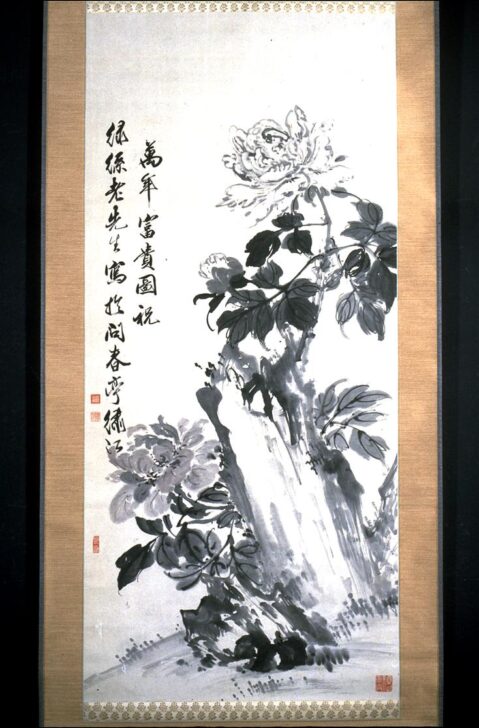Peonies and Rock
Kumashiro Yūhi

Description
Kumashiro Yûhi is the earliest of the artists in this exhibition, and the one who had the most direct access to Chinese sources. He was a native of Nagasaki, the port city in Kyûshû that was for most of the Edo period Japan’s sole point of contact with foreign trade. There was a thriving Chinese quarter in the city, and the hereditary occupation of Yûhi’s natal family was translating Chinese. He learned Chinese at an early age, and was able to study directly from imported paintings. In 1731, Yûhi had the chance to study with a Chinese artist, when Shen Nanpin (íæìÏÂ_, 1682–after 1733) arrived in Nagasaki for a stay of nearly two years. Nanpin specialized in bird-and-flower painting, a genre that in China had been associated with professional artists because the subject demanded a high level of skill. Most of Nanpin’s extant works are done in bright colors on silk, in a style that is both realistic and decorative. Here Yûhi moves away from Nanpin’s commercially popular model to a more personal and expressionistic style, in bold ink wash.
Maribeth Graybill, for the exhibition "Japanese Visions of China," 9/21/02 - 1/26/03
---
Kumashiro Yûhi benefited greatly from and was inspired by direct access to Chinese sources. A native of Nagasaki, the port city in Kyûshû that was for most of the Edo period Japan’s sole point of contact with foreign trade, Yûhi learned Chinese at an early age, and was able to study directly from imported paintings. In 1731, Yûhi had the chance to study with Chinese artist Shen Nanpin (circa 1682–after 1733), who specialized in bird-and-flower painting, a genre that in China had been associated with professional artists rather than amateur literati painters. Most of Nanpin’s extant works incorporate bright colors on silk, in a style that is both realistic and decorative. Here Yûhi moves away from Nanpin’s commercially popular model to a more personal and expressionistic style, executed in bold ink wash.
(6/28/10)
(Japanese Gallery Rotation, Spring 2010)
Subject Matter:
In 1731, Yûhi had the chance to study with a Chinese artist, when Shen Nanpin (ca. 1682–after 1733) arrived in Nagasaki for a stay of nearly two years. Nanpin specialized in bird-and-flower painting, of which this painting is similar in style.
Physical Description:
Peonies in full bloom grow as if from a rock or tree stump. A calligraphic inscription is on the left side.
Usage Rights:
If you are interested in using an image for a publication, please visit https://umma.umich.edu/request-image/ for more information and to fill out the online Image Rights and Reproductions Request Form.